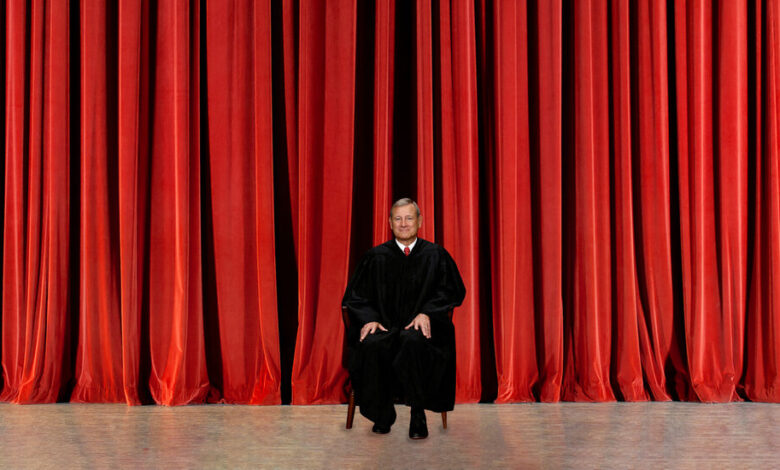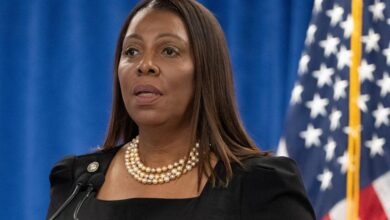Opinion | John Roberts Is on a Collision Course With Trump

It is possible that these threats are theater, meant to cow the justices into compliance. But it is more likely that they are not. Mr. Trump is clearly well aware that the court is unpopular and no longer commands the reverence that long protected it from attacks. According to a Marquette Law School poll, a majority of Americans believe that politics, not law, drives most Supreme Court decisions. The regal lifestyle of Justices Samuel Alito and Clarence Thomas — bankrolled by wealthy benefactors and only disclosed under duress — has also eroded the esteem the court once enjoyed. There was little outcry when Mr. Trump maligned the court in the past, when he called justices “incompetent” and “dumb,” when he accused the court of sending “shotgun blasts into the face” of Republicans. He has felt free — perhaps never freer than now — to show contempt for judges, juries, lawyers, the rule of law and the Constitution. The question is not whether Mr. Trump will defy the court, but how soon and to what extent.
A clash is coming, despite the court’s sympathy for some aspects of the Trump agenda. In recent years, with gathering force, Chief Justice Roberts and his conservative supermajority have been crippling federal agencies, dismantling environmental regulations, weakening voter protections, stripping away reproductive rights and undercutting racial diversity — advance work, all of it, for Project 2025. The assault on the “deep state” echoes the chief justice’s own disdain for government “functionaries” and his indulgent view of executive power. In a 2020 opinion, he expanded the president’s power to fire civil servants without cause. That decision, as Justice Elena Kagan wrote in dissent, “wipes out” the independence of the agency in question, the Consumer Financial Protection Bureau. And now Mr. Trump, following this lead, has sought to wipe out the agency itself. He has effectively shut the C.F.P.B. down, locking out its staff members and preparing to return its funding to the Federal Reserve. When you put a man above the law, as the court did in last year’s presidential immunity case, he’s going to act like he’s above the law.
At some point, presumably, the justices will draw the line. They may allow Mr. Trump to purge parts of the federal government, but it is hard to imagine them endorsing his attempt to revoke birthright citizenship. His executive order, issued on his first day in office, is dressed up in legal language but directly contravenes the 14th Amendment, as more than one judge has pointed out. The court also seems unlikely to countenance Mr. Trump’s freeze of funds that Congress appropriated. A long line of cases, including a recent 7-2 opinion by Justice Thomas, affirms “the principle of legislative supremacy over fiscal matters.” As the administration continues, by increasingly artful means, to undermine court orders that it restart spending, the fundamental issue becomes starker and clearer. “If presidents can impound appropriated funds at any time and for any reason,” Georgetown Law’s Stephen Vladeck observes, “then there’s not much point to having a legislature.”
In any consequential ruling, Chief Justice Roberts will likely be tempted to narrow his reasoning, soften his tone and, if possible, leave Mr. Trump out of it. Such was the case in Trump v. Anderson, which tiptoed awkwardly around the central question of whether Mr. Trump had engaged in insurrection and should therefore be barred from federal office. The chief justice’s instinct for self-preservation is strong, as is his faith in sleights of hand. But that faith would be disastrous here. A vague, performatively nuanced opinion will almost certainly be perceived by the White House as weakness — and a green light to further lawlessness.
On Aug. 22, 1973, the day that a Federal District Court judge heard arguments in the Watergate tapes case, President Richard Nixon refused to say whether he would comply with anything less than a “definitive order” by the Supreme Court. Nearly a year later, an 8-0 court ruled against him. (Justice William Rehnquist, who had served in the Nixon administration, recused himself.) For Chief Justice Roberts, unanimity will be hard — even impossible — to achieve in most cases concerning Mr. Trump’s actions as president. During Mr. Trump’s first term, when the court ruled that he had improperly revoked the immigration program known as DACA, the justices split 5-4; in a dissent, Justice Thomas accused the chief justice of writing an opinion with “no basis in law.” But even a divided decision can be definitive by the force of its logic, the directness of its language, the unambiguity of its intent. Nothing less will suffice.




